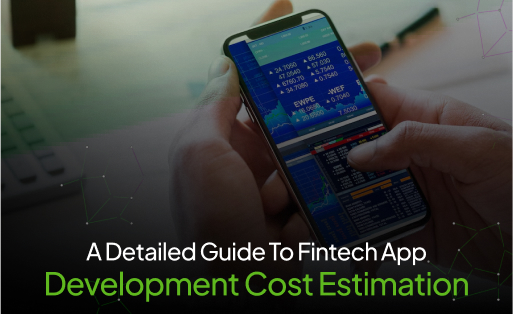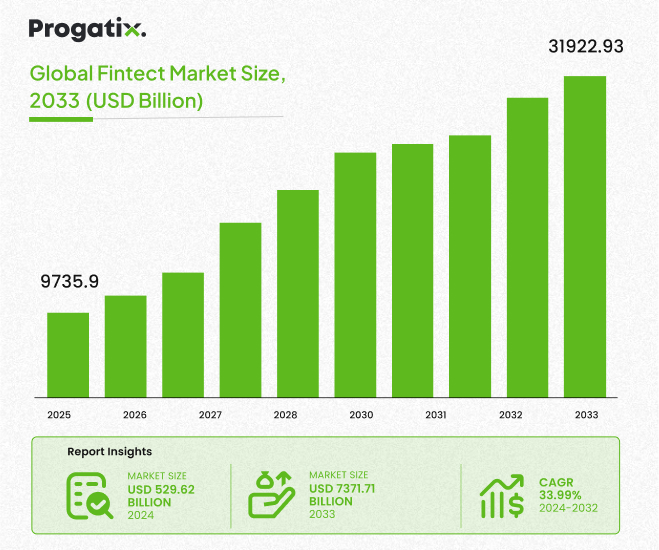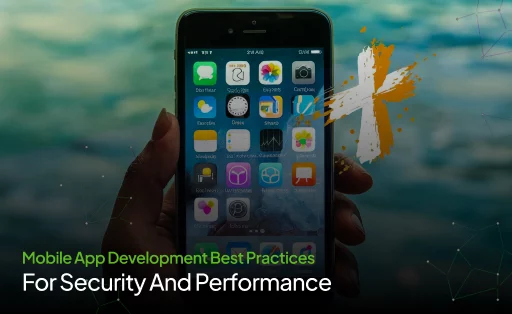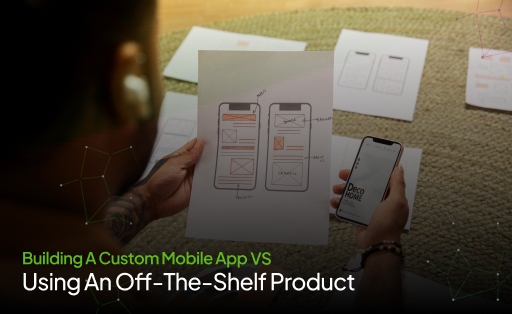A Detailed Guide To Fintech App Development Cost Estimation App Development

With more people opting for online methods for their banking and financial requirements, fintech is growing rapidly. There has never been a better moment for founders or CTOs to take advantage of the expanding mobile banking trend. According to Business Research Insights, the global fintech market size was around USD 9735.9 billion in 2024 and is anticipated to grow to USD 31922.93 billion by 2033, at a CAGR of 13.9% during the forecast period.
Prior to joining the fintech trend, you should calculate the cost of developing a fintech app. Unfortunately, it’s not easy to figure out how much it will cost to design a fintech software. There’s no set amount. Rather, a number of aspects will need to be taken into account.
This blog will reveal a few factors that regulate the cost to build a fintech app. More significantly, we’ll look into ways to optimize your cost without cooperating on quality, security, and compliance.
Let’s Begin.
What Makes Up The Fintech Development Cost?
Fintech app development cost depends on different factors. Even if we are building seemingly identical apps, one might be more costly than the other because of the factors such as, the team you employ, app’s complexity, design needs and more.
The Development Team
For the development of a fintech app, you are required to hire a team of app developers, QA engineers, designers, project managers, and other supporting roles. Though, relying on the hiring mode, the cost you pay could be more or less.
In-House Hiring
In a nutshell, hiring an internal team seems to be the most cost-friendly option. Also, employing a long-term permanent team offers the stability that SMBs look for. However, being mindful of long-term commitments is necessary because it can expand your operating costs.
For instance, you hire a fintech developer to build your product. Along with paying their actual cost, you will also need to give them perks, insurance, training, and other required advantages. Additionally, you will need to keep your in-house team after they have completed their project.
App Complexity
Another significant cost factor is the app itself. A basic fintech app needs only basic features such as user login, spending tracker, and account management to make less cost for the building. That’s because developers can spend less time and effort to finish the whole project.
Alternatively, be ready to pay more if your app needs intricate features. For instance, a blockchain-powered investment app is significantly more challenging to build. You will be required to hire skilled talents such as blockchain developers, AI professionals and financial analysts during the app development.
Be cautious of every feature, whether complex or basic, which may need work to be executed for front-end, UI/UX, backend, and QA tests, which adds up to the cost. Additionally, since fintech is a tightly regulated industry, you will be required to allot a budget to meet the compliance needs including PCI-DSS, GDPR and other financial regulations.
Outstaffing
Outstaffing is identical to outsourcing, except that you are in complete control of the remote developers hired by an external agency. When you outstaff, the contracted agency will hire and onboard a developers team on your behalf. Then, you combine the external team with your internal one. Numerous SMBs opt for our staff because it offers comprehensive control over the development process without going into hiring more. Outstaffing helps you balance stability with financial obligations.
Development Team’s Location
Where you hire from is just as important as who you hire. Whether you like it or not, the location of your developers has a direct impact on the cost of developing a fintech app. If the developers are based in cities like Los Angeles, New York, or London, where the cost of living is high, then you have to pay more when contracting them. Likewise, you pay less fees if the development team functions in countries such as the Philippines, Ukraine, India, and China.
For instance, fintech developers operating in India only charge $20 to $50 per hour, whereas those in the US charge $100 to $150. Founders would naturally prefer to select the least expensive developers, but taking into account a variety of variables, such as industry knowledge, particular technologies, programming languages, portfolio, time zone, and communication, is necessary. Ukrainian developers, for instance, charge around 50$ per hour, which gives you high-quality work and substantial savings for that price.
Outsourcing
Normally, startups are not financially ready enough for in-house hiring which brings out the next option of IT outsourcing. In IT outsourcing, you engage an independent contractor that offers fintech app development services. Instead of paying fixed costs, you exercise a collaboration model including the time and material or a dedicated team.
In outsourcing you only have to pay for the time and services needed. This option frees you from having to personally handle the developers. As the contracted agency takes control of the development, you can emphasize on your business features.
Number of Integrations
Most fintech apps need third party services to work. For instance, if you build a banking app similar to Chime, you will have to integrate with payment gateways, KYC checks and traditional bank services. Similarly, an investment app might require AI integration to offer forecasting and support real-time cross-border transactions, correspondingly.
The more integration you have in your app, the higher the fintech app development cost. This will raise a question: if they build those services from scratch, would they save more? Well, if you opt to develop the payment gateway, AI predictive model, or other technologies on your own, then you will end up paying more. Moreover, you will have to pay a huge opportunity cost as it takes longer to launch your project on the market.
Therefore, it’s best to select the right integrations for efficiency and cost. For instance, you can integrate an open banking API to exchange financial data safely with banks instead of building the whole data pipeline.
Design Complexity
One of the most common fintech startup mistakes is launching an app that does not cater to the user’s expectations. If your app fails to engage with the users, then they will go for another competitor. Thus, it’s important to emphasize on the app’s UI/UX even though you have paid more.
A simple app needs a basic interface and upfront customer journey, which takes less time to build and is inexpensive.
Cost Breakdown for Fintech App Development
While a precise figure cannot be given but an estimate of a fintech development app estimate for every stage could be provided. Here is a standard software development process that Progatix follows. Thus here is the explanation of what emerges in each and the cost they acquire.
Pre-development Phase
Firstly, before beginning the development, all the activities that need to get done are mapped out. It helps us and our clients to comprehend where most of our time and resources will be spent.
Planning and Discovery
Before the development of a fintech app, we need to make sure that it will ultimately be determined, and simply, the app should solve a real problem. To observe, we begin a discovery phase, in which we take interviews and gather feedback from the target audience.
From the findings, we decide upon the tech stack, skills, integrations and other resources that would be required. Also, at this point we decide over the fintech security and compliance needs to make precise provisions, such as, GDPR, PCI-DSS and KYC. Additionally, our team proposes the clients regarding the estimated timeline and crucial milestones.
For instance, we found that the target audience for a green investment app development project was extremely uncertain. We couldn’t create a user-preferred app without transparency. We thus took the time to survey users in order to figure out their precise requirements and problems.
Time frame: one to two months
Cost: $25,000.
Development Phase
Several business owners and CTOs become disappointed when their budget gets blown out in the conceptual stage and had to use cheap design and development resources. They are left with a product that no one wants to use.
When creating an app, our developers designate the tasks needed into diverse stages. Every stage has its purpose and needs specific skill sets, tech stacks, and resources. We keep it in the following way:
- 60% in design, user testing sprints, and development.
- 30% is committed to getting to product definition.
- 10% goes to go-to-market and ready for launch.
This approach is beneficial for our clients in diverse ways. This is the correct amount of time to find the product-market fit, to design and create features that make you highlight and reach the business objectives. Also, it’s a win-win regarding your fintech app development budget.
App Design
The first stage of development is design, in which we emphasize creating a mockup or wireframe for the app. Our UI/UX designer maps the customer expedition into visual layouts. Then, they utilize the mockups to authenticate initial assumptions with the target audience. Occasionally, numerous iterations are needed before we build an acceptable prototype.
Know that getting the fintech UX/UI design right is the top priority, even if you may have to invest some time and money at this point. Bad UX/UI could not be a concern for mobile apps, particularly those in the finance industry. In order to pay bills, transfer money, perceive reports, or carry out any other action, users must be able to simply browse the app.
As an example, let’s consider PayPal. It is one of the more widely used payment apps and is adept at several UI/UX concepts. PayPal helps customers finish their jobs by offering clear instructions, a simple style, and a good combination of text and images. Users only need to follow a handful of easy steps to transfer or receive money.
Time frame: one month
Expense: $10,000
Front-end Development
The web or mobile app accounts for a significant portion of the cost of developing fintech apps. To make the wireframe a reality, financial developers write code for dozens or even hundreds of hours. Developers choose the essential elements required to create the MVP at this point as well.
During the development of a fintech app, developers emphasize on individual features or components required by the users such as, account management, payment transfer, interactive charts and so on. If your app needs a number of such features, the fintech app development cost will considerably become higher.
You might have to pay a higher cost, depending on the platform you select. For instance, you must develop apps for iOS, Android, and the web if you want to interact with users on these platforms. It goes without saying that building cross-platform apps will lower the development cost. This results in a single codebase that can be generated for each platform.
Time frame: two to six months
Expense: $90,000 to $130,000
AI Model Training (optional)
This step is optional. If you want an AI-powered fintech app, you will be required to provide the training, integrate with the AI model, and fine-tune. For instance, a thorough learning model can enable a lending app to automatically evaluate and allot an applicant’s credit score.
To train the AI model, we have to choose a dataset that accurately represents the targeted client. Next, customize the codes to enable the app to securely and reliably share data with the AI model. All of these take more time and money to complete. The model can be trained as the front end is being developed, which is good news.
In a sense, we make sure you don’t experience any delays simply because you’re using AI to innovate your software. For instance, we integrated Tired Banker, a financial platform that simplifies investment data using artificial intelligence. By integrating GPT with their online platform, we were able to meet the project deadline.
Cost and Duration: based on the scope
Backend and API Integration
This is another stage that adds considerably to the final cost of a fintech app development. The backend part of the apps involve databases, servers, data security and needed third-party services. And they are important to make sure your app runs dependably, amenability and resistant to threats.
Suppose you wish to create a Venmo-style payment app. All of the payment information must be safely kept in a database. We will assist you in selecting either private or public cloud infrastructure to host the database and the application, depending on the data residency requirements.
After that, our developers will link the app with third-party service providers such as, Plaid and Yodlee as well as payment gateways. Our developers still need to write code and test the solution for different use cases, even though interaction with the provider’s API is easier.
At the same time, we use encryption to protect all of the data that the app gathers, stores, and processes. To lower data risks, we additionally use additional security measures, including role-based access and multi-factor authentication.
Therefore, it should come as no surprise that backend and integration efforts contribute significantly to the overall cost. Building a strong foundation is crucial, though, so that you can easily and safely scale your program as needed.
Time frame: more than six months
Expense: $60,000.
Application Testing
An app launches successfully only when your app is stable, safe, and free from serious bugs. To accomplish that, you need to meticulously test your app. At Progatix, it means integrating diverse types of tests during the whole software development phase.
For instance, we find bugs, technical issues, and vulnerabilities by running a few of the tests that are:
- Unit test to evaluate the app’s several components.
- An integration test that ensures all the third-party services work together.
- A usability test evaluates user feedback to evaluate the user-friendliness of the software.
Software testing guarantees that you are off to a good beginning after launching the program to the public, even though it will maximize the initial cost.
Time Frame: Six months (QA often lasts the entire development process)
Expense: $50,000
Compliance and Certification
Fintech is a highly regulated space, which means that you are strictly required to follow the regulations that are implemented. For instance, PCI-DSS, PSD-2, and GDPR are acts that secure customer details while ensuring payment security. Moreover, you will be required to comply with AML, KYC, and other related local banking acts.
Your app must successfully complete a number of certification procedures in order to be in compliance with these acts. To have your app authorized, you ideally ought to form a compliance committee and collaborate closely with the relevant authorities. Once more, this leads to the investment of money, time, and human resources.
Nevertheless, if you collaborate with a skilled fintech development team, you can save compliance expenses. Suppose we are approached by a client who wants to develop an investment app for the US market. The United States, as you are aware, has some of the strictest financial laws. Thus, working together with our customers, we could provide the app in complete compliance within six months.
Time frame: three months
Expense: $40,000.
Post-Launch Costs
Don’t ignore the post-launch costs, even though the development period contributes to the majority of the cost. If not, you might face cash flow problems after launch.
Technical Support and Maintenance
After the app launches, you will be required to maintain it so users keep on enjoying a disruption-free experience. Businesses must set aside money for recurring needs in order to accomplish that.
For instance,
- Bugs must be fixed, new features must be released, and developers must offer round-the-clock technical support.
- Fintech regulations are prone to alteration; thus, developers must adapt their apps accordingly.
- Security teams must keep an eye out for flaws in third-party components and your programs. Security flaws will need to be fixed if they are found.
By partnering with a fintech app development company like Progatix, you can lower these frequent costs. Take inspiration from a cardless case where the app’s architecture and logic had to be redesigned along with reorganizing the code.
Time Frame: Indefinite
Cost: Around $50 per hour
Marketing
Since it has a direct impact on the app’s success, marketing is important to highlight even though it isn’t technically a fintech app development expense. Founders need to set aside money for advertising, social media marketing, SEO, and other initiatives in addition to employing fintech developers and other development expenses.
Time frame: Indefinite
Cost: more than $20,000.
Consult Our Fintech Developers for Cost Estimation!
Let's ConnectTypes of Fintech Apps and Their Costs
The type of fintech app also affects the cost of development. Certain financial apps cost more because they need greater functionality to work. The apps that evolved from popular fintech startup product ideas and their projections are examined below.
Investment Apps
Investment apps enable customers to trade stocks, monitor market performance and buy cryptos in real-time and more. Apps such as eToro, Robinhood and Acorn have collected a sizable user base. Frequently, such apps use AI to offer predictions and recommendations that investors utilize to make informed decisions.
An investment app must integrate several financial services and adhere to stringent rules such as the Securities Exchange Act, Electronic Fund Transfer Act, and GDPR, similar to other fintech apps.
Cost estimate: $73,000 to $210,000
Banking Apps
Banking apps allow customers to skip the queue and access substitute financing accommodations. With features like simple account setup, cross-border transfers, and easy payment, neo-banks like Chime, Revolut, and Nubank have placed traditional banks to the test in recent years. Major Banks such as CitiBank, Bank of America, and Chase Bank have responded by releasing applications that improve their internal services in an effort to stay relevant.
Estimated Cost: 150,000 to $350,000
Personal Finance Apps
Personal finance apps assist users track expenses, plan budgets, save and control their finances. For instance, Aspiration, a fintech startup allows users to save and add to the environmental causes from a mobile app. Other prominent apps in this space are YNAB, Quicken Simplifi and Pocket Guard.
Usually, personal finance apps are reasonable to build because they do not need complex technologies such as deep learning and blockchain models.
Estimated cost: $50,000 to $130,000
Lending Apps
Lending apps lessen loan approval time and enable lenders to evaluate their risks more precisely. Usually, these apps implement AI models to score applicants so lenders can regulate the qualified lending amount. Traditional lending institutions are progressively digitizing their credit instruments, but peer-to-peer loan apps such as SoFi, Upstart, and Zest AI are getting attention for their adaptability.
When developing a lending app, developers should pay equal attention to simplifying loan distribution, profile checks, repayment and more.
Estimated cost: $90,000 to $268,000
Insurance Apps
Insurance apps help insurers and clients address few of the most persistent issues in the industry-extensive approval cost and time. By simplifying the whole workflow on an app, clients can access reasonable premiums while insurers can handle documents and process claims more efficiently.
Numerous insurance apps for the travel, automotive, business, and other industries have been released as an outcome of the increasing demand. For instance, consumers can get insurance on their phones with the help of the GEICO, CoverFox, and Mintpro applications.
Cost estimate: $50,000 to $140,000
How to Optimize Cost
One of the hurdles of scaling a fintech product is making costs manageable. Over the years, Progatix has helped numerous fintech companies reduce costs by following certain strategies when developing the app. Here are the tips:
Begin with MVP
Don’t include every feature you had in mind for the original release, however tempting it may be. Otherwise, you will face a number of dangers with your app. Engaging users isn’t guaranteed by an app with dozens of great features. Instead, it could become disorganized, unclear, and unstable. Additionally, the extra hours required to implement those functionalities lead to a high development cost.
Alternatively, we recommend beginning with an MVP which comprises only of key features that will offer the most influence. For instance, if you are building a lending app, emphasize o features such as credit scoring, automated repayment and loan application. Once your app is proven to be successful, you can integrate good-to-have features such as gamification or multi-currency support.
Outsourcing vs. In-House Development
It’s not only about what’s less expensive; it’s also about what will help you expand more strategically. As previously stated, in-house hiring gives you greater control, but it will require a long-term financial commitment. Recurring expenses might add up over time if you’re operating a startup or SMB on a limited budget.
However, outsourcing offers you the adaptability to scale your development cost consequently. Though you may need to spend more to build an app, you won’t have to keep a sizeable after-launch cost. Also, since the development work will be coordinated by the outsourced team, you could focus on expanding your company.
Integrate Third Party Services
Another strategy to reduce fintech development costs is to employ third-party services whenever possible. Here at Progatix, we don’t try to reinvent the wheel. Rather, we interface our app with third-party fintech companies such as Plaid, which provides users instant access to data-sharing and financial features.
How to Stand Out in the Fintech Market?
North America, which is home to more than 12,000 financial technology companies and has had modest growth from 2023, continued to dominate the global fintech setting throughout 2024. Therefore, you will have to make your fintech app to be highlighted in the increasingly crowded industry. The good news is that numerous technologies that support fintech growth are growing, and you must capitalize on them.
AI and ML
Huge language models such as GPT surpasses in having conversations naturally and examining data at scale. They can be involved with your app to allow chatbots, predictive analytics or fraud detection. Bloomberg, for instance, developed BloombergGPT, a specialized finance LLM dedicated to helping its employees in better catering to their customers.
Also, instead of training a model from the very beginning, you can fine-tune an existing model for fintech use cases. Our developers are skilled in fine-tuning and organizing AI models for fintech apps. Progatix can help you shorten the time-to-market while building a secure and responsible AI-powered app.
Big Data Analytics
Fintech applications gather data that could be used to help users, your company, and other stakeholders. An investment app, for example, can deliver tailored recommendations by evaluating market trends, risk tolerance, and transaction history. Finance managers can also use these data to estimate risks, forecast market movements, and make improved decisions.
Determine the objective of the data analytics implementation to lessen the chance of gathering too much data, which can put a load on data storage and create security issues.
A New Level of Data Security
Due to the nature of the applications, you must be aware of data threats when building fintech apps. To implant confidence amongst users, your app must secure user data with encryption, multi-factor authentication, and other security measures.
Pay close attention to new security risks and improve your software. Include persistent security testing in the process of development. This fintech security checklist is open for download to help your team.
Why Choose Progatix For Your Fintech App Development
Progatix has extensive experience in providing fintech app development services since we have helped companies globally build investment, neobank, personal finance, and other relevant apps. Our developers are skilled in using innovative technologies that strengthen modern financial applications. More significantly, we are aware of the required regulations you must comply with, ensuring our apps meet all required compliance standards.
Final Words
When developing fintech software, pricing is certainly a significant aspect, but it is by no means the only one. Thus, it’s better to connect with a good and reputable fintech app development company that also faces significant obstacles in navigating technological complexity and regulatory compliance while ensuring strong data protection. Effectively addressing these components is essential to creating a scalable, safe, and profitable application. Progatix is here to help you navigate the process and make sure your fintech app development journey is effective and seamless if these problems seem overwhelming.
Hire Expert Fintech Developers for Cost-Effective Solutions!
Let's Connect



 Let's Discuss Your Tech Solutions
Let's Discuss Your Tech Solutions 






